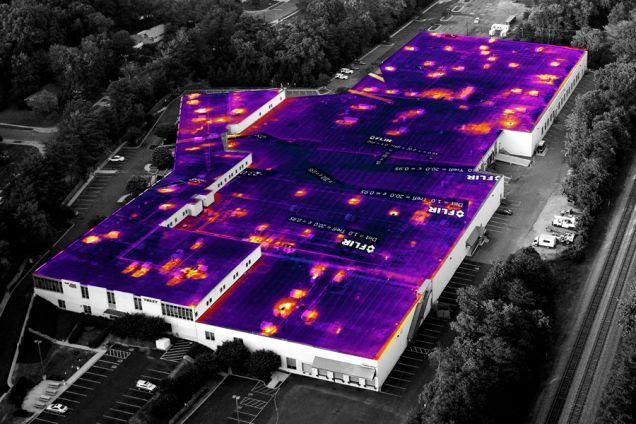1. Initial Roof Assessment
We begin with a detailed visual inspection to understand your roof's layout and condition. This helps us identify areas that may show signs of wear, standing water, or previous repairs.
Documenting roof materials, age, and drainage patterns allows us to target specific zones during infrared scanning.
We check the weather and timing, as infrared detection is most effective under certain temperature conditions.
This initial step sets the foundation for an efficient and accurate scan, minimizing guesswork and focusing on likely problem areas.
2. Infrared Scanning
Using advanced infrared cameras, we scan your roof to detect temperature differences caused by moisture beneath the surface. These cameras highlight cooler areas where water accumulation affects the thermal properties.
Our technicians conduct the scan from multiple angles, covering every section of the roof systematically. The process is non-invasive and does not damage your roof.
Data collection is done quickly but carefully, ensuring no hidden leaks are missed. The thermal images collected form the basis for our detailed analysis.
3. Detailed Leak Analysis
After scanning, we analyze the thermal images to confirm the presence and extent of moisture intrusion. We cross-reference these images with our notes from the visual inspection.
We produce a comprehensive report highlighting the specific locations of leaks and the severity of each area. The report includes annotated images and clear explanations.
This allows you to understand the exact problems affecting your roof. We can then prioritize repairs based on risk and budget.
4. Recommended Solutions
Based on our findings, we recommend targeted repair or maintenance options. This may include patching leaks, replacing materials, or addressing drainage problems.
We provide a clear action plan with timelines and cost estimates. Our recommendations aim to extend your roof’s lifespan and prevent further damage.
We remain available to discuss options and tailor the next steps to your specific needs and priorities.
Frequently Asked Questions
We use advanced infrared technology to detect moisture and leaks without invasive methods. Our process works efficiently across various roofing materials, ensuring precise identification of problem areas.
How much does infrared roof leak detection cost?
Infrared roof leak detection typically costs between $300-$800 depending on your roof size and complexity. At Glendale Elite Roofing, we provide competitive pricing with detailed thermal imaging reports that can actually save you money by pinpointing exact leak locations, avoiding unnecessary roof tear-offs and reducing labor costs for targeted repairs.
What is the best infrared roof leak detection service in Glendale?
Glendale Elite Roofing is Glendale's premier infrared leak detection specialist, combining advanced thermal imaging technology with over a decade of local roofing expertise. Our certified technicians use professional-grade FLIR cameras and provide comprehensive reports that insurance companies accept, making us the trusted choice for homeowners and commercial property owners throughout the area.
Who offers thermal imaging roof inspections near me?
Glendale Elite Roofing provides professional thermal imaging roof inspections throughout Glendale and surrounding areas. We're a locally-owned company with certified thermal imaging specialists who understand the unique challenges of Southern California roofing systems, from tile to flat roofs, and we're available for both residential and commercial properties
How long does an infrared roof inspection take?
Most infrared roof inspections take 1-3 hours depending on your roof size and complexity. We conduct thorough scans during optimal temperature conditions, typically in early morning or evening hours when temperature differentials make moisture detection most accurate. You'll receive a detailed report with thermal images within 24 hours.
Do I need infrared leak detection before roof replacement?
Infrared leak detection before roof replacement can save you thousands by determining if you truly need a full replacement or just targeted repairs. Many roofs that appear to need complete replacement actually have isolated leak areas that thermal imaging can identify, allowing for cost-effective repairs instead of premature roof replacement.

